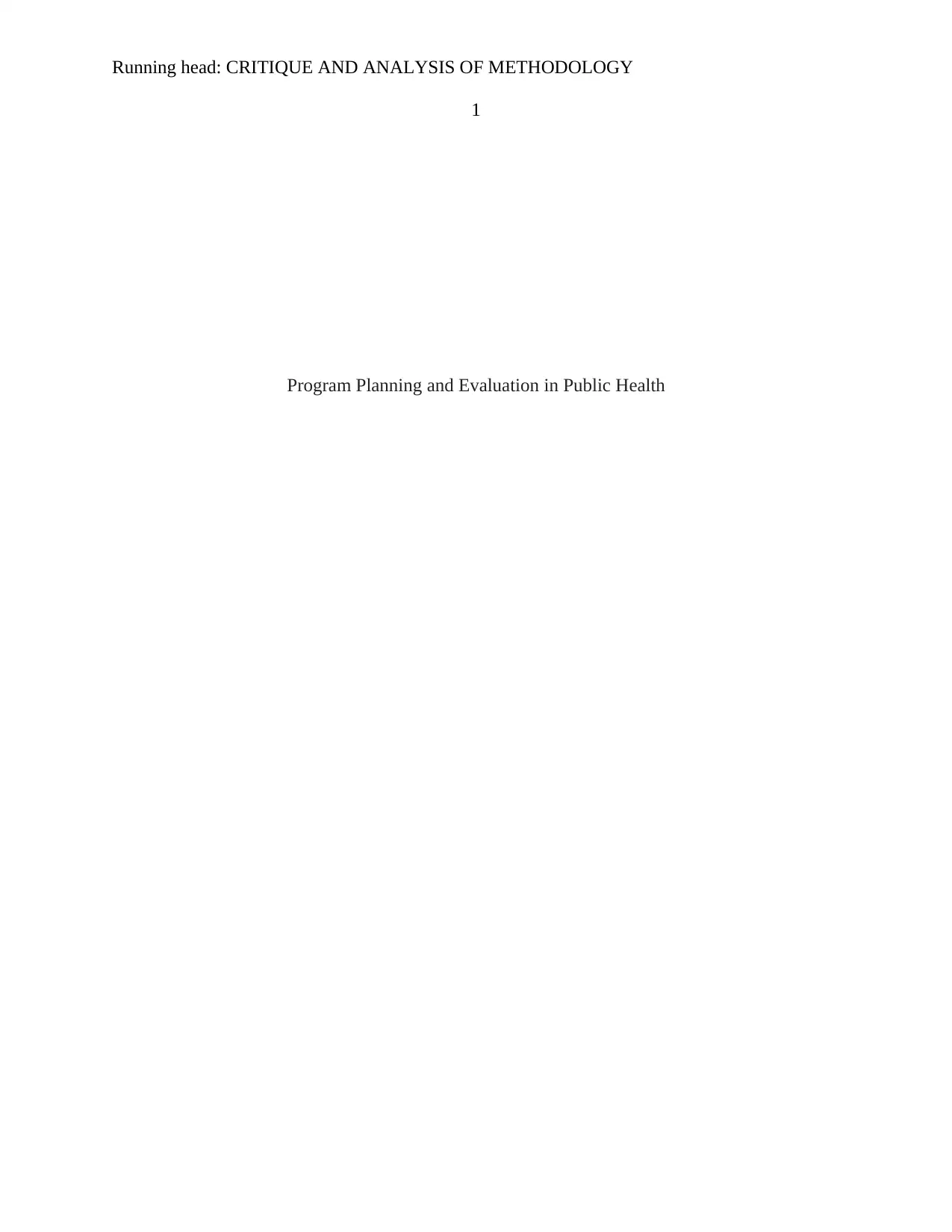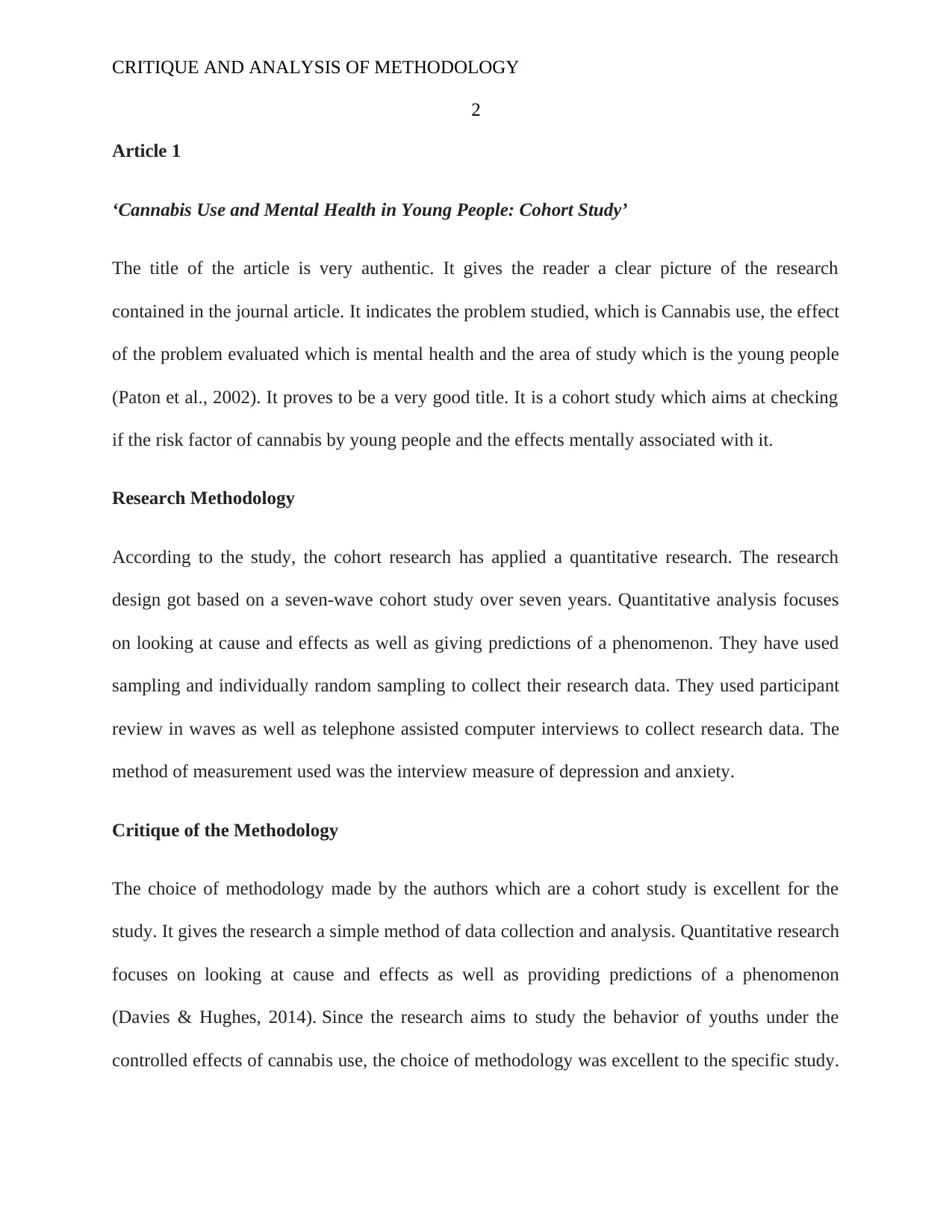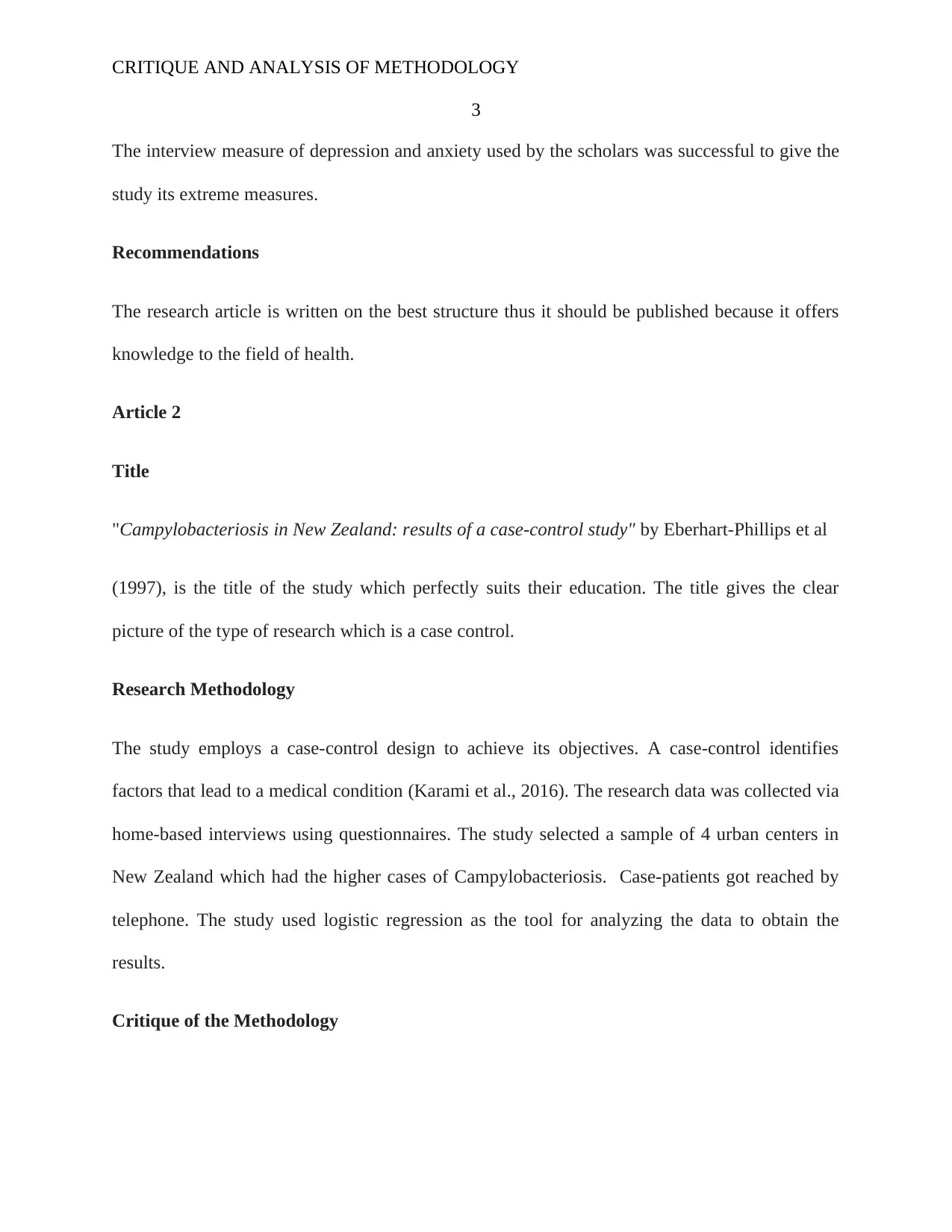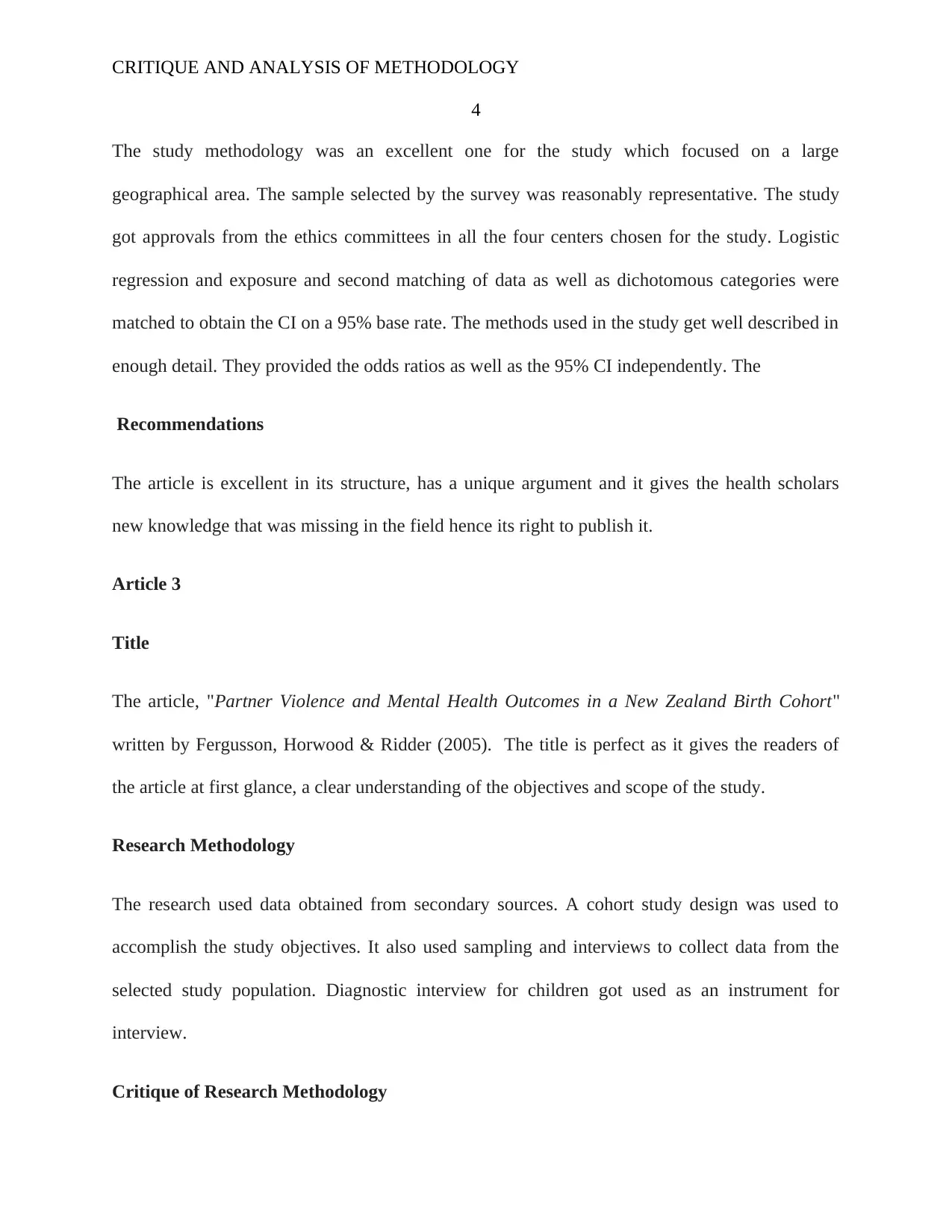Program Planning and Evaluation in Public Health: Methodology Critique
VerifiedAdded on 2023/06/10
|7
|1155
|164
Report
AI Summary
This report provides a critique and analysis of research methodologies used in public health, focusing on three articles. The first article, a cohort study, investigates the relationship between cannabis use and mental health in young people. The second article employs a case-control design to examine campylobacteriosis in New Zealand. The third article, also a cohort study, explores the link between partner violence and mental health outcomes. The analysis evaluates the strengths and weaknesses of each study's methodology, including sampling techniques, data collection methods, and statistical analyses. The report highlights the suitability of each methodology for its respective research question, offering recommendations for improving the studies and their potential for publication. The critique also considers ethical considerations and the overall structure of each article, providing a comprehensive assessment of the research approaches used in the field of public health.

Running head: CRITIQUE AND ANALYSIS OF METHODOLOGY
1
Program Planning and Evaluation in Public Health
1
Program Planning and Evaluation in Public Health
Paraphrase This Document
Need a fresh take? Get an instant paraphrase of this document with our AI Paraphraser

CRITIQUE AND ANALYSIS OF METHODOLOGY
2
Article 1
‘Cannabis Use and Mental Health in Young People: Cohort Study’
The title of the article is very authentic. It gives the reader a clear picture of the research
contained in the journal article. It indicates the problem studied, which is Cannabis use, the effect
of the problem evaluated which is mental health and the area of study which is the young people
(Paton et al., 2002). It proves to be a very good title. It is a cohort study which aims at checking
if the risk factor of cannabis by young people and the effects mentally associated with it.
Research Methodology
According to the study, the cohort research has applied a quantitative research. The research
design got based on a seven-wave cohort study over seven years. Quantitative analysis focuses
on looking at cause and effects as well as giving predictions of a phenomenon. They have used
sampling and individually random sampling to collect their research data. They used participant
review in waves as well as telephone assisted computer interviews to collect research data. The
method of measurement used was the interview measure of depression and anxiety.
Critique of the Methodology
The choice of methodology made by the authors which are a cohort study is excellent for the
study. It gives the research a simple method of data collection and analysis. Quantitative research
focuses on looking at cause and effects as well as providing predictions of a phenomenon
(Davies & Hughes, 2014). Since the research aims to study the behavior of youths under the
controlled effects of cannabis use, the choice of methodology was excellent to the specific study.
2
Article 1
‘Cannabis Use and Mental Health in Young People: Cohort Study’
The title of the article is very authentic. It gives the reader a clear picture of the research
contained in the journal article. It indicates the problem studied, which is Cannabis use, the effect
of the problem evaluated which is mental health and the area of study which is the young people
(Paton et al., 2002). It proves to be a very good title. It is a cohort study which aims at checking
if the risk factor of cannabis by young people and the effects mentally associated with it.
Research Methodology
According to the study, the cohort research has applied a quantitative research. The research
design got based on a seven-wave cohort study over seven years. Quantitative analysis focuses
on looking at cause and effects as well as giving predictions of a phenomenon. They have used
sampling and individually random sampling to collect their research data. They used participant
review in waves as well as telephone assisted computer interviews to collect research data. The
method of measurement used was the interview measure of depression and anxiety.
Critique of the Methodology
The choice of methodology made by the authors which are a cohort study is excellent for the
study. It gives the research a simple method of data collection and analysis. Quantitative research
focuses on looking at cause and effects as well as providing predictions of a phenomenon
(Davies & Hughes, 2014). Since the research aims to study the behavior of youths under the
controlled effects of cannabis use, the choice of methodology was excellent to the specific study.

CRITIQUE AND ANALYSIS OF METHODOLOGY
3
The interview measure of depression and anxiety used by the scholars was successful to give the
study its extreme measures.
Recommendations
The research article is written on the best structure thus it should be published because it offers
knowledge to the field of health.
Article 2
Title
"Campylobacteriosis in New Zealand: results of a case-control study" by Eberhart-Phillips et al
(1997), is the title of the study which perfectly suits their education. The title gives the clear
picture of the type of research which is a case control.
Research Methodology
The study employs a case-control design to achieve its objectives. A case-control identifies
factors that lead to a medical condition (Karami et al., 2016). The research data was collected via
home-based interviews using questionnaires. The study selected a sample of 4 urban centers in
New Zealand which had the higher cases of Campylobacteriosis. Case-patients got reached by
telephone. The study used logistic regression as the tool for analyzing the data to obtain the
results.
Critique of the Methodology
3
The interview measure of depression and anxiety used by the scholars was successful to give the
study its extreme measures.
Recommendations
The research article is written on the best structure thus it should be published because it offers
knowledge to the field of health.
Article 2
Title
"Campylobacteriosis in New Zealand: results of a case-control study" by Eberhart-Phillips et al
(1997), is the title of the study which perfectly suits their education. The title gives the clear
picture of the type of research which is a case control.
Research Methodology
The study employs a case-control design to achieve its objectives. A case-control identifies
factors that lead to a medical condition (Karami et al., 2016). The research data was collected via
home-based interviews using questionnaires. The study selected a sample of 4 urban centers in
New Zealand which had the higher cases of Campylobacteriosis. Case-patients got reached by
telephone. The study used logistic regression as the tool for analyzing the data to obtain the
results.
Critique of the Methodology
⊘ This is a preview!⊘
Do you want full access?
Subscribe today to unlock all pages.

Trusted by 1+ million students worldwide

CRITIQUE AND ANALYSIS OF METHODOLOGY
4
The study methodology was an excellent one for the study which focused on a large
geographical area. The sample selected by the survey was reasonably representative. The study
got approvals from the ethics committees in all the four centers chosen for the study. Logistic
regression and exposure and second matching of data as well as dichotomous categories were
matched to obtain the CI on a 95% base rate. The methods used in the study get well described in
enough detail. They provided the odds ratios as well as the 95% CI independently. The
Recommendations
The article is excellent in its structure, has a unique argument and it gives the health scholars
new knowledge that was missing in the field hence its right to publish it.
Article 3
Title
The article, "Partner Violence and Mental Health Outcomes in a New Zealand Birth Cohort"
written by Fergusson, Horwood & Ridder (2005). The title is perfect as it gives the readers of
the article at first glance, a clear understanding of the objectives and scope of the study.
Research Methodology
The research used data obtained from secondary sources. A cohort study design was used to
accomplish the study objectives. It also used sampling and interviews to collect data from the
selected study population. Diagnostic interview for children got used as an instrument for
interview.
Critique of Research Methodology
4
The study methodology was an excellent one for the study which focused on a large
geographical area. The sample selected by the survey was reasonably representative. The study
got approvals from the ethics committees in all the four centers chosen for the study. Logistic
regression and exposure and second matching of data as well as dichotomous categories were
matched to obtain the CI on a 95% base rate. The methods used in the study get well described in
enough detail. They provided the odds ratios as well as the 95% CI independently. The
Recommendations
The article is excellent in its structure, has a unique argument and it gives the health scholars
new knowledge that was missing in the field hence its right to publish it.
Article 3
Title
The article, "Partner Violence and Mental Health Outcomes in a New Zealand Birth Cohort"
written by Fergusson, Horwood & Ridder (2005). The title is perfect as it gives the readers of
the article at first glance, a clear understanding of the objectives and scope of the study.
Research Methodology
The research used data obtained from secondary sources. A cohort study design was used to
accomplish the study objectives. It also used sampling and interviews to collect data from the
selected study population. Diagnostic interview for children got used as an instrument for
interview.
Critique of Research Methodology
Paraphrase This Document
Need a fresh take? Get an instant paraphrase of this document with our AI Paraphraser

CRITIQUE AND ANALYSIS OF METHODOLOGY
5
The research methodology approach selected was a cohort study, and it is an excellent method
for sampling which involved multiple samples (cohorts). The examples helped the research to
meet its objectives admirably. The collection of data was appropriate to the research question.
Information about the participants gets adequately given in the methodology. The study also
made efforts to avoid and eliminate biasness. The study observed ethical considerations and
standards.
Recommendations
The article is right to be published as a journal because it is well structured, gives diverse
knowledge on the phenomena to scholars.
5
The research methodology approach selected was a cohort study, and it is an excellent method
for sampling which involved multiple samples (cohorts). The examples helped the research to
meet its objectives admirably. The collection of data was appropriate to the research question.
Information about the participants gets adequately given in the methodology. The study also
made efforts to avoid and eliminate biasness. The study observed ethical considerations and
standards.
Recommendations
The article is right to be published as a journal because it is well structured, gives diverse
knowledge on the phenomena to scholars.

CRITIQUE AND ANALYSIS OF METHODOLOGY
6
References
Eberhart-Phillips, J., Walker, N., Garrett, N., Bell, D., Sinclair, D., Rainger, W., & Bates, M.
(1997). Campylobacteriosis in New Zealand: results of a case-control study. Journal of
Epidemiology & Community Health, 51(6), 686-691. DOI:
https://doi.org/10.1111/j.1741-3737.2005.00202.x
Fergusson, D. M., Horwood, L. J., & Ridder, E. M. (2005). Partner violence and mental health
outcomes in a New Zealand birth cohort. Journal of marriage and family, 67(5), 1103-
1119. DOI: https://doi.org/10.1111/j.1741-3737.2005.00202.x
Patton, G. C., Coffey, C., Carlin, J. B., Degenhardt, L., Lynskey, M., & Hall, W. (2002).
Cannabis use and mental health in young people: cohort study. Bmj, 325(7374), 1195-
1198. DOI: https://doi.org/10.1136/bmj.325.7374.1195
Karami, S., Daughtery, S. E., Schwartz, K., Davis, F. G., Ruterbusch, J. J., Wacholder, S., ... &
Moore, L. E. (2016). Analgesic use and risk of renal cell carcinoma: A case‐control,
cohort and meta‐analytic assessment. International journal of cancer, 139(3), 584-592.
Davies, M. B., & Hughes, N. (2014). Doing a successful research project: Using qualitative or
quantitative methods. Macmillan International Higher Education.
6
References
Eberhart-Phillips, J., Walker, N., Garrett, N., Bell, D., Sinclair, D., Rainger, W., & Bates, M.
(1997). Campylobacteriosis in New Zealand: results of a case-control study. Journal of
Epidemiology & Community Health, 51(6), 686-691. DOI:
https://doi.org/10.1111/j.1741-3737.2005.00202.x
Fergusson, D. M., Horwood, L. J., & Ridder, E. M. (2005). Partner violence and mental health
outcomes in a New Zealand birth cohort. Journal of marriage and family, 67(5), 1103-
1119. DOI: https://doi.org/10.1111/j.1741-3737.2005.00202.x
Patton, G. C., Coffey, C., Carlin, J. B., Degenhardt, L., Lynskey, M., & Hall, W. (2002).
Cannabis use and mental health in young people: cohort study. Bmj, 325(7374), 1195-
1198. DOI: https://doi.org/10.1136/bmj.325.7374.1195
Karami, S., Daughtery, S. E., Schwartz, K., Davis, F. G., Ruterbusch, J. J., Wacholder, S., ... &
Moore, L. E. (2016). Analgesic use and risk of renal cell carcinoma: A case‐control,
cohort and meta‐analytic assessment. International journal of cancer, 139(3), 584-592.
Davies, M. B., & Hughes, N. (2014). Doing a successful research project: Using qualitative or
quantitative methods. Macmillan International Higher Education.
⊘ This is a preview!⊘
Do you want full access?
Subscribe today to unlock all pages.

Trusted by 1+ million students worldwide

CRITIQUE AND ANALYSIS OF METHODOLOGY
7
7
1 out of 7
Related Documents
Your All-in-One AI-Powered Toolkit for Academic Success.
+13062052269
info@desklib.com
Available 24*7 on WhatsApp / Email
![[object Object]](/_next/static/media/star-bottom.7253800d.svg)
Unlock your academic potential
Copyright © 2020–2025 A2Z Services. All Rights Reserved. Developed and managed by ZUCOL.





